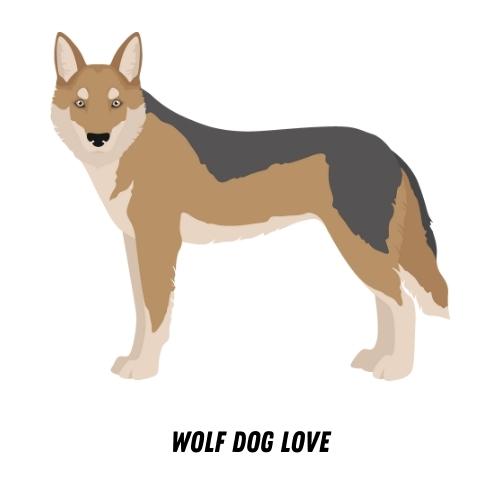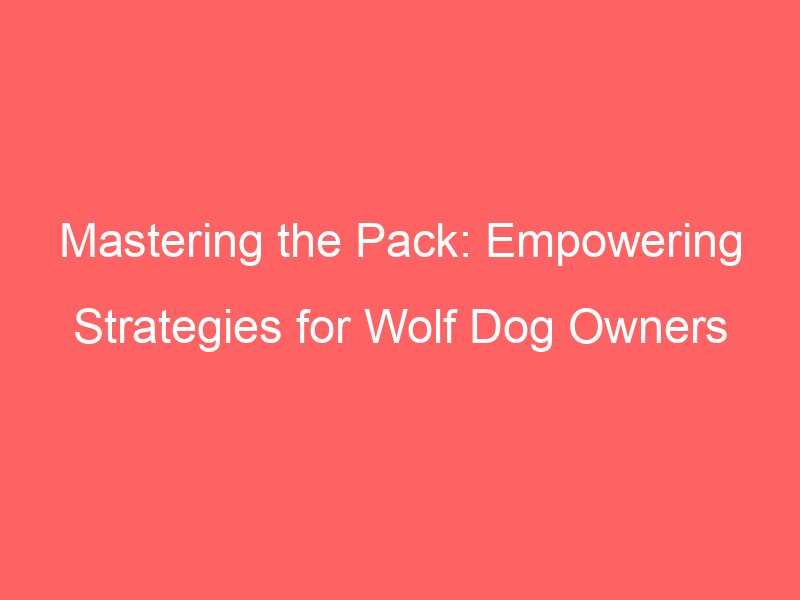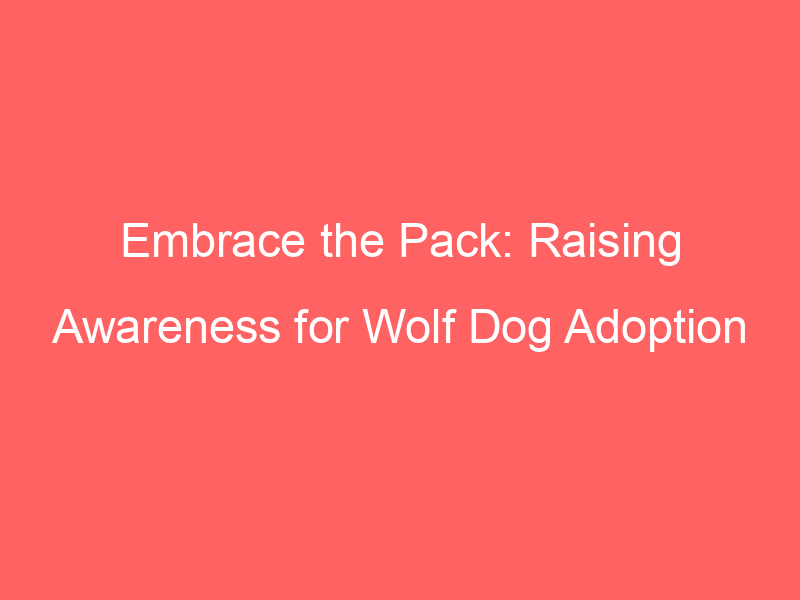Introduction to Wolf Dog Ownership
Wolf dogs, a unique blend of domestic dog and wild wolf, are captivating creatures. They combine the loyalty of a dog with the spirit of a wolf. However, owning a wolf dog is not a decision to be taken lightly. It comes with its own set of unique challenges and rewards.
- Understanding the Unique Challenges of Wolf Dog Ownership
- Benefits of Owning a Wolf Dog
Wolf dogs are not your average pets. They require a lot of time, patience, and understanding. Their wild instincts often make them more independent and harder to train than most dogs. They also need a lot of space to run and play, and they require a diet that closely mimics what they would eat in the wild.
Wolf dogs can also be wary of strangers and may not get along well with other pets. They have a strong prey drive, which can make them a risk around smaller animals. They also have a tendency to howl, which might not be appreciated by your neighbors.
Despite the challenges, owning a wolf dog can be an incredibly rewarding experience. They are intelligent, loyal, and have a unique beauty that is unmatched. They can form deep bonds with their owners and can be very protective.
Wolf dogs are also very active and love to play. They can make excellent hiking or running partners, and they love to explore. Their keen senses make them excellent watchdogs, and their unique appearance is sure to turn heads wherever they go.
In conclusion, owning a wolf dog is a big responsibility, but it can also bring a lot of joy and fulfillment. It’s important to do your research and make sure you’re prepared for the challenges before bringing a wolf dog into your home.
Understanding Wolf Dog Behavior
Wolf dogs, a unique blend of domestic dog and wild wolf, exhibit behaviors that can be challenging for owners. Understanding these behaviors is key to forming a strong bond with your wolf dog and ensuring their well-being.
Common Wolf Dog Behavior Issues
Wolf dogs can exhibit a range of behavior issues. Here are some of the most common:
- Aggression: Wolf dogs can sometimes show signs of aggression. This can be due to a variety of factors, including fear, territoriality, or a lack of proper socialization. It’s important to remember that aggression is not a natural state for wolf dogs, and it can often be managed with the right approach and training.
- Separation Anxiety: Like many dogs, wolf dogs can suffer from separation anxiety. This is a condition where a dog becomes extremely anxious when left alone. Symptoms can include excessive barking, destructive behavior, and even attempts to escape.
- Excessive Howling: Howling is a natural behavior for wolves, and wolf dogs can inherit this trait. While occasional howling is normal, excessive howling can be a sign of stress or discomfort. It’s important to understand the triggers for this behavior and to work on strategies to help your wolf dog feel more secure.
Understanding these behaviors is the first step towards addressing them. With patience, consistency, and the right training techniques, you can help your wolf dog overcome these issues and live a happy, healthy life.
Interpreting Wolf Dog Behavior
Interpreting the behavior of your wolf dog is crucial for a harmonious relationship. This involves understanding their body language and recognizing signs of stress or discomfort. Let’s explore these two aspects in detail.
- Understanding Body Language
Wolf dogs, like all canines, communicate primarily through body language. By observing their posture, tail position, ear movement, and facial expressions, you can gain insights into their emotions and intentions.
| Body Part | Relaxed | Agitated |
|---|---|---|
| Posture | Loose, relaxed | Stiff, tense |
| Tail | Low or wagging | High, stiff, or tucked |
| Ears | Forward or relaxed | Back or flat against head |
| Facial Expression | Soft, relaxed | Tense, wrinkled brow, showing teeth |
Remember, these are general guidelines. Each wolf dog is unique, and their body language can vary. It’s essential to spend time with your pet to understand their specific signals.
- Recognizing Signs of Stress or Discomfort
Wolf dogs may exhibit certain behaviors when they’re stressed or uncomfortable. These can include excessive panting, pacing, drooling, or destructive behavior. They might also show changes in appetite or sleep patterns.
It’s important to note that these signs can also indicate medical issues. If your wolf dog is showing these behaviors, it’s a good idea to consult with a veterinarian to rule out any health problems.
Understanding your wolf dog’s behavior is a journey. It requires patience, observation, and a lot of love. But the reward is a deep, meaningful bond with your pet.
Wolf Dog Training Techniques
Training a wolf dog requires patience, consistency, and understanding. Let’s start with the basics.
Basic Training
Basic training is the foundation of any successful wolf dog training program. It includes two essential components: house training and leash training.
-
House Training
House training is the first step in teaching your wolf dog to live harmoniously in your home. This process involves teaching your pet where it’s appropriate to relieve themselves, and where it’s not. It’s important to start house training as soon as possible, ideally when your wolf dog is still a puppy. Puppies have a natural instinct to keep their living area clean, which can make the process easier.
Remember, patience and consistency are key. Reward your wolf dog when they do the right thing, and gently correct them when they don’t. Over time, they’ll learn what’s expected of them.
-
Leash Training
Leash training is crucial for keeping your wolf dog safe and well-behaved during walks. Wolf dogs are strong and energetic animals, and without proper leash training, they can be hard to control.
Start by getting your wolf dog used to wearing a collar and leash. Once they’re comfortable, you can start teaching them to walk by your side. Use treats and positive reinforcement to reward good behavior. Remember, it’s important to be patient and consistent. Leash training can take time, but it’s worth the effort.
Basic training is just the beginning. Once your wolf dog has mastered these skills, you can move on to more advanced training techniques. But remember, every wolf dog is unique. What works for one might not work for another. It’s important to be patient, consistent, and understanding throughout the training process.
Advanced Training
Once your wolf dog has mastered the basics, it’s time to move on to advanced training. This includes recall and agility training. These techniques are a bit more complex, but they’re essential for keeping your wolf dog mentally stimulated and physically fit.
- Recall Training
- Start in a quiet, distraction-free environment. Call your dog’s name and reward them when they come to you.
- Gradually increase the distance between you and your dog, and introduce distractions. Always reward your dog for coming back to you.
- Never punish your dog for not coming when called. This will only make them less likely to respond to your calls in the future.
- Agility Training
- Start with simple obstacles and gradually introduce more complex ones.
- Always make sure the training is fun and positive. Reward your dog for successfully completing an obstacle.
- Don’t push your dog too hard. If they’re not enjoying the training, take a break and try again later.
Recall training is all about teaching your wolf dog to come back to you when called. This is a crucial skill for any dog, but it’s especially important for wolf dogs due to their natural instincts to roam and explore. Here’s how you can do it:
Remember, patience and consistency are key in recall training. It may take some time, but the results are worth it.
Agility training involves teaching your wolf dog to navigate through a course of obstacles, such as jumps, tunnels, and weave poles. This is a great way to keep your dog physically active and mentally stimulated. Plus, it’s a lot of fun for both of you!
Agility training can be a great bonding experience for you and your wolf dog. It’s also a fantastic way to show off your dog’s skills and intelligence!
In conclusion, advanced training is a crucial part of owning a wolf dog. It not only keeps your dog physically and mentally fit, but it also strengthens the bond between you and your pet. So, don’t be afraid to take your training to the next level!
Problem-solving for Wolf Dogs
Wolf dogs, with their unique blend of domestic and wild traits, can sometimes present challenges that require specialized problem-solving strategies. One such challenge is aggression. Let’s delve into how we can address this issue effectively.
Addressing Aggression
Aggression in wolf dogs can be a serious concern, but it’s important to remember that it’s usually a symptom of an underlying issue. Addressing aggression involves two main steps: understanding the root cause and implementing behavior modification strategies.
- Understanding the root cause
- Implementing behavior modification strategies
Aggression in wolf dogs is often a response to fear, stress, or territorial instincts. It’s important to identify the triggers that lead to aggressive behavior. This could be a specific situation, person, or even another animal. By understanding the root cause, we can take the first step towards addressing the issue.
Once the root cause of aggression has been identified, the next step is to implement behavior modification strategies. These strategies aim to change the dog’s response to the triggers. This could involve positive reinforcement for calm behavior, gradual desensitization to the trigger, or redirection of the dog’s attention. Remember, consistency is key in behavior modification.
Addressing aggression in wolf dogs is not an overnight process. It requires patience, understanding, and a commitment to consistent training. But with the right approach, it’s possible to transform an aggressive wolf dog into a calm, well-behaved companion.
Managing Separation Anxiety
Separation anxiety is a common issue that many wolf dog owners face. It’s a condition where your pet becomes anxious and stressed when they are left alone or separated from their owners. However, there are effective ways to manage this problem. Let’s explore two main strategies.
- Creating a Safe Space
- Gradual Desensitization
Creating a safe and comfortable space for your wolf dog can significantly reduce their anxiety. This space could be a specific room or a corner in your house where they can retreat to when they feel anxious. It should be a quiet, comfortable, and secure area where they can relax.
Equip this space with their favorite toys, a comfortable bed, and perhaps a piece of your clothing. Your scent can provide a sense of comfort and security to your pet. Remember, this space should be a sanctuary for your wolf dog, a place where they can feel safe and relaxed.
Gradual desensitization is another effective strategy to manage separation anxiety. This involves gradually getting your wolf dog used to being alone. Start by leaving your pet alone for a few minutes each day, and then gradually increase this time.
For example, you could start by stepping out of the room for five minutes, then ten minutes, and so on. Over time, your wolf dog will learn that being alone is not something to fear. It’s important to be patient and consistent with this process.
In conclusion, managing separation anxiety in wolf dogs involves creating a safe space and using gradual desensitization techniques. With patience and consistency, your pet will learn to feel comfortable even when they are alone. Remember, every wolf dog is unique, and what works for one may not work for another. Always observe your pet’s behavior and adjust your strategies as needed.
Empowering Dog Owners
As a dog owner, especially of a wolf dog, it’s crucial to feel confident and empowered. This section will guide you on how to build your confidence in handling your wolf dog.
Building Confidence in Handling Wolf Dogs
Handling a wolf dog can be a challenging task, but with the right approach, you can build your confidence and create a strong bond with your pet. Here are two key factors to consider:
- Importance of Consistency
- Benefits of Positive Reinforcement
Consistency is the cornerstone of any successful training program. Wolf dogs are intelligent creatures that thrive on routine and predictability. By being consistent in your commands and reactions, your wolf dog will learn what is expected of them, leading to a more harmonious relationship.
Positive reinforcement is a powerful tool in dog training. It involves rewarding your wolf dog for good behavior, which encourages them to repeat it. This method not only builds trust but also fosters a positive environment for your pet. A study by the Journal of Veterinary Behavior found that dogs trained using positive reinforcement exhibited fewer behavioral problems.
In conclusion, building confidence in handling your wolf dog involves consistency in your training methods and using positive reinforcement to encourage good behavior. By following these steps, you can create a strong bond with your wolf dog and feel more empowered as an owner.
Strategies for Dog Problems
Wolf dogs are unique creatures, and owning one can be a rewarding experience. However, they can sometimes present challenges that require special strategies. Here are two key strategies that can help you navigate through these problems.
- Seeking Professional Help
- Joining a Support Group
When faced with a problem that seems too big to handle, it’s always a good idea to seek professional help. Professionals such as veterinarians, dog trainers, and animal behaviorists have the knowledge and experience to help you understand and manage your wolf dog’s behavior.
For instance, if your wolf dog is showing signs of aggression or fear, a professional can help identify the root cause and suggest appropriate interventions. They can also provide you with tools and techniques to manage these behaviors at home.
Remember, there’s no shame in asking for help. In fact, seeking professional assistance can often prevent small problems from becoming bigger ones.
Another effective strategy is joining a support group. Support groups are communities of people who share similar experiences. In a wolf dog owner’s support group, you can connect with others who understand what you’re going through.
These groups can be a great source of advice, encouragement, and camaraderie. You can share your experiences, ask questions, and learn from others who have faced similar challenges. Plus, it’s always comforting to know that you’re not alone.
Whether it’s a local group that meets in person or an online community, a support group can be a valuable resource for any wolf dog owner.
In conclusion, dealing with wolf dog problems can be challenging, but you don’t have to face them alone. By seeking professional help and joining a support group, you can gain the knowledge and support you need to navigate these challenges successfully.
Wolf Dog Care
Wolf dogs are unique pets that require specific care to ensure their health and happiness. One of the most crucial aspects of wolf dog care is their nutrition and health. Let’s delve into the dietary needs of wolf dogs and common health issues they may face.
Nutrition and Health
Wolf dogs have specific dietary needs that differ from regular domestic dogs. They also have unique health issues that need to be addressed to ensure their well-being.
-
Dietary needs of Wolf Dogs
Wolf dogs are carnivores and require a diet rich in protein. They thrive on a diet that includes raw meat, bones, and organs. However, they also need a small amount of fruits and vegetables to provide essential vitamins and minerals. Avoid feeding them grains and processed foods as these can lead to health problems.
Food Type Percentage in Diet Raw Meat 60% Bones and Organs 30% Fruits and Vegetables 10% -
Common health issues and prevention
Wolf dogs are generally healthy but can be prone to certain health issues. These include hip dysplasia, heart disease, and eye problems. Regular vet check-ups are essential for early detection and treatment of these conditions.
Prevention is better than cure. Regular exercise, a balanced diet, and regular vet check-ups can help prevent many health issues. It’s also important to keep your wolf dog’s vaccinations up to date to protect them from common canine diseases.
Remember, a healthy wolf dog is a happy wolf dog. By understanding their dietary needs and being aware of common health issues, you can provide the best care for your wolf dog.
Exercise and Enrichment
As a wolf dog owner, it’s crucial to understand the importance of both physical activity and mental stimulation for your pet’s overall health and happiness. Let’s dive deeper into these two aspects.
- Importance of Physical Activity
Physical activity is a key component of wolf dog care. Wolf dogs are naturally active and energetic creatures. They require regular exercise to maintain a healthy weight and to keep their muscles strong and flexible. Exercise also helps to prevent common health problems such as obesity and heart disease.
Moreover, physical activity is a great way for your wolf dog to expend energy and reduce boredom, which can lead to destructive behavior. It’s recommended that wolf dogs get at least an hour of exercise each day, but this can vary depending on their age, health, and energy level. This can include walks, playtime in the yard, or even structured activities like agility training.
- Enrichment Activities for Mental Stimulation
Just as physical activity is important, so too is mental stimulation. Wolf dogs are intelligent animals that crave mental challenges. Without proper mental stimulation, they can become bored and potentially destructive.
Enrichment activities are a great way to keep your wolf dog’s mind sharp. This can include puzzle toys, obedience training, or even simple games like hide and seek. These activities not only challenge your wolf dog mentally, but they also provide an opportunity for you to bond with your pet.
Remember, a well-exercised and mentally stimulated wolf dog is a happy and healthy one. By incorporating both physical activity and enrichment activities into your wolf dog’s routine, you can ensure they live a fulfilling and enriched life.
| Activity | Benefits |
|---|---|
| Physical Exercise | Keeps wolf dogs healthy, reduces boredom, and prevents destructive behavior. |
| Mental Stimulation | Keeps wolf dogs mentally sharp, prevents boredom, and strengthens the bond between owner and pet. |
Conclusion: Mastering the Pack
As we wrap up our discussion on wolf dog ownership, it’s important to remember that mastering the pack isn’t a one-time event. It’s a journey that involves embracing challenges, reaping rewards, and continuously learning and adapting. Let’s delve into these aspects a bit more.
- Embracing the challenges and rewards of Wolf Dog Ownership
Wolf dog ownership is not for the faint-hearted. It requires patience, understanding, and a lot of love. The challenges can sometimes be overwhelming, from understanding their unique behavior to implementing effective training techniques and problem-solving strategies. However, the rewards are equally profound.
Imagine the bond you’ll form with your wolf dog. It’s a bond that goes beyond the typical owner-pet relationship. It’s a bond of mutual respect, trust, and understanding. The joy of seeing your wolf dog grow, learn, and adapt to its environment is a reward that makes all the challenges worthwhile.
- Continued learning and adaptation
Mastering the pack doesn’t end with overcoming the initial challenges. It’s a continuous process of learning and adaptation. Wolf dogs are intelligent creatures, and they are always learning. As an owner, you must also be willing to learn and adapt.
Stay updated with the latest research on wolf dog behavior, training techniques, and care. Attend seminars, read books, join online forums, and engage with other wolf dog owners. The more you learn, the better equipped you’ll be to handle the challenges that come your way.
In conclusion, mastering the pack is a journey filled with challenges and rewards. It requires a commitment to continuous learning and adaptation. But with patience, understanding, and love, you can form a bond with your wolf dog that’s truly one of a kind.
| Key Aspects | Description |
|---|---|
| Challenges | Understanding wolf dog behavior, implementing training techniques, problem-solving |
| Rewards | Forming a bond of mutual respect, trust, and understanding with your wolf dog |
| Continued Learning and Adaptation | Staying updated with latest research, attending seminars, reading books, joining online forums, engaging with other wolf dog owners |








